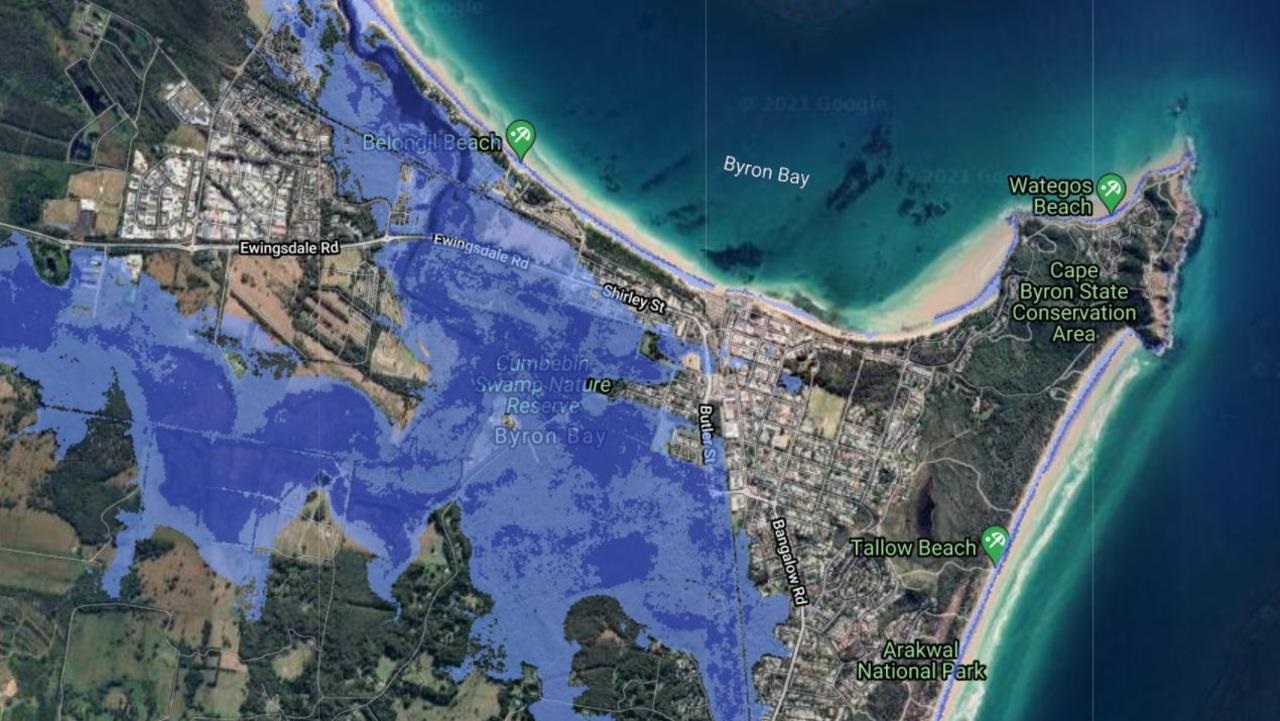Updated mapping shows Aussie beaches and homes at risk from sea level rise

Some of Australia’s most pristine coastlines and iconic beaches could be washed away if action on climate change is not taken.
Updated interactive mapping from Coastal Risk Australia reveals the damage that beaches like Byron Bay and Manly in NSW, as well as Bells Beach and Brighton in Victoria could experience if the world follows a high emissions pathway.
It comes as analysis from the Reserve Bank of Australia found house prices were expected to fall by 10 per cent or more in some areas by 2050 because of climate change.
Global sea levels have already risen by 20cm (between 1901 and 2018) and the Australasia region, which includes New Zealand, has experienced even higher rates than the global average. More coastal flooding is expected as levels rise even further.
The latest predictions from the Intergovernmental Panel on Climate Change (IPCC) report reveal further increases are largely locked in, with a rise of about 15cm to 30cm expected by around 2050.
“There is high confidence that [the] sea level will continue to rise, and well beyond the end of this century,” Dr James Goldie of the Monash Climate Change Communication Research Hub told news.com.au last month.
“This will contribute to increased coastal flooding and shoreline retreat along sandy coasts throughout Australia.”
The changes beyond 2050 will largely depend on what the world does to bring down emissions.
Based on the current climate pledges that countries have made, there could be 3-4C of warming by 2100 and this is likely to see sea levels rise by about 70cm.
If warming is kept to 2C, sea level rise could be as low as 50cm.
If the world follows a high emissions path, levels could rise between 63cm and 101cm.
The Coastal Risk Australia website, developed in partnership by FrontierSI and NGIS Australia, has based its mapping on a rise of 84cm, which is a mid-range value for the high emissions scenario.
Previously it used a figure of 74cm for its high emissions scenario.
The update shows that a sea level rise of 84cm combined with a high tide could see Byron Bay beach and large areas around its waterways inundated.
It also found homes and streets in suburbs in Victoria, Queensland, Western Australia, South Australia and Tasmania could be increasingly flooded.
“Australia is facing significant challenges, one of which is being more resilient to climate. The Coastal Risk Australia tool aims to place scientific modelling into the hands of the people so they can see for themselves how the areas they live in could be impacted in the future by climate change,” FrontierSI chief executive officer Graeme Kernich said.
NGIS Australia executive director Nathan Eaton said the organisation wanted to communicate how the IPCC’s latest projections would impact Australian coastal communities.
“By 2050, sea level change of 15cm to 30cm will be unavoidable. This means that coastal flooding will become worse during storm surges,” he said.
Large sandy stretches of Australian beaches could be washed away, including:
– Bells Beach, Brighton, Ocean Grove, St Kilda and Wye River beaches in Victoria
– Byron Bay and Manly in NSW
– Agnes Water, Burleigh Heads, Noosa and Whitehaven in Queensland
– Cottesloe and Coogee beaches in Western Australia
– Glenelg in South Australia
Homes and streets in the following suburbs could be increasingly flooded, including:
– Albert Park, the Docklands, Middle Park, St Kilda and Williamstown in Victoria
– Bulimba and Hamilton in Queensland
– North Fremantle in Western Australia
– West Lakes in South Australia
– Lauderdale in Tasmania
Popular coastal tourist spots could be inundated, including:
– Queenscliff and Point Lonsdale in Victoria
– Ballina and Byron Bay in NSW
– Busselton and Mandurah in Western Australia
– Cairns and Port Douglas in Queensland
– Hindmarsh Island and Victor Harbor in South Australia
Source: news.com.au




